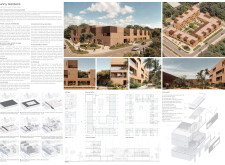5 key facts about this project
### Project Overview
Located in Binak, the Sunny Gardens housing initiative aims to address the increasing demand for quality housing within a dynamic socio-economic context. The architectural framework is characterized by adaptability and aligns with the principles of sustainability, focusing on enhancing community welfare through well-considered design.
### Spatial Strategy and Community Engagement
The design promotes communal living through a carefully organized layout that facilitates interaction among residents. Accessibility is prioritized throughout the site, with both residential and communal spaces arranged to encourage social engagement while providing privacy. Green areas are integrated within the development, contributing to a sense of community and enhancing the overall living experience.
### Materiality and Environmental Considerations
The project employs materials selected for their functionality and compatibility with local environmental conditions. Concrete blocks provide structural integrity, while wood and plastered finishes offer a warm aesthetic. Large glass elements ensure ample natural light and ventilation, and the use of Corten steel for cladding introduces a weathered texture that resonates with the surrounding landscape. Additionally, sustainability efforts are emphasized through the use of local resources, contributing to a reduced carbon footprint.
### Sustainability Initiatives
A range of sustainability measures has been incorporated into the design. Rainwater harvesting systems are installed to minimize water waste, while green roofs and facades promote biodiversity and thermal regulation. Solar panels enhance energy efficiency, reducing dependency on non-renewable resources. These features reflect a commitment to environmentally mindful construction practices, positioning the project as a model for future developments.
The housing units themselves are designed to accommodate various family sizes and lifestyles, with residential modules clustered to foster community interaction. Commercial spaces are strategically placed to support local businesses, ensuring convenience for residents and contributing to a vibrant neighborhood atmosphere.


















































